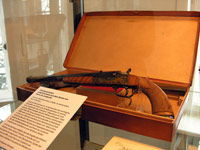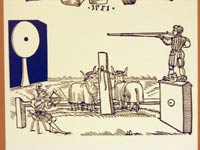The German Shooting Federation (Deutscher Schützenbund) opened a new museum dedicated to target shooting in May 2004. On a recent vacation trip to German, I had an opportunity to visit this museum. Since the preservation and presentation of the history of the shooting sports is important to shooters in the United States as well as in Germany, I thought I would prepare this brief report on the new “Deutsches Schützenmuseum.”
 |
| The CMP’s Director of Civilian Marksmanship, Gary Anderson, discusses one of the most important arms in the new German Shooting Museum with the Museum Curator, Stefan Gruß. The engraved Aydt falling block single shot rifle was a prize of honor for the first German Federal Shooting Festival in 1862.
|
The German Shooting Federation was founded in 1861 by Duke Ernst II of Saxon-Coburg and Gotha. The founding took place during the same time period as the founding of the British NRA in 1859 and the National Rifle Association of America in 1871, but for quite different reasons. The British and American federations were established to foster military preparedness through rifle marksmanship competition. The German federation, in contrast, was founded before the many disunited German states and free cities were united into one country. During the 1850s and 1860s when German politics struggled with how to unite Germany, Duke Ernst II called for founding a unified German Shooting Federation. He felt that if German shooting clubs could unite into a single organization, this could help promote national political unity.
 |
| The founding of the German Shooting Federation in 1861 by Duke Ernst II of Saxony-Coburg and Gotha is chronicled in the museum. The German federation was founded as part of a movement by German sports federations to unite in order to
foster national political unity.
|
After Bismarck united Germany into a single state in 1871, the German Shooting Federation changed its focus from patriotism and national unity to promoting traditional German shooting festival competitions and the newly emerging sport competitions embodied by the shooting events in the Olympic Games that began in 1896 and the World Shooting Championships that began in 1897.
The German federation actually founded its first shooting museum in 1909 in Nürnberg, but that museum closed in 1936 when the Nazi government was closing shooting clubs and sports organizations throughout Germany. The collections of the first German shooting museum unfortunately were dispersed after World War II. The impetus for a new German Shooting Museum came from the current German Shooting Federation President, Josef Ambacher of Munich. Ambacher believes that the history of German shooters and their traditions must be preserved and made available to the public and that a shooting museum was an essential means of doing that.
 |
| The displays in the German Shooting Museum begin with marksmanship endeavors by Stone Age men and continue through the development of shooting clubs in German cities in the Middle Ages.
|
A site for the new museum was provided by a descendant of Duke Ernst II, Prince Andreas of Saxon-Coburg and Gotha, who arranged for space in his family’s Callenberg Castle near the north Bavarian city of Coburg to become the museum site. One wing of the castle, with three floors of display space, was leased to the German Federation to develop as a museum. The area has been divided into
many distinct exhibition areas that are being developed as funds become available. To date, about half of the development plan has been executed.
The displays in the museum chronicle the history of marksmanship from the Stone Age through Ancient Egypt and Greece
through the Middle Ages when German citizens in cities practiced crossbow marksmanship on city shooting stands so they could be ready to defend their city. Their regular shooting practice led to forming shooting clubs and then to organizing shooting festivals and competitions among shooters from neighboring cities.
 |
| This official invitation for shooters from neighboring cities to participate in a shooting festival in 1606 is a prized display item in the new German Shooting Museum. Since there was no common standard of measurement in that time, the solid black line on the left side of the document is the standard of measurement to be used for this competition. The targets were to be placed
300 times that distance from the shooters.
|
The history of German shooting clubs is an especially rich history that is inextricably interwoven with the history of the cities where the clubs were founded and developed. Historic items from typical German shooting clubs are an important part of the museum displays.
Soon after the German Shooting Federation was founded in 1861, German “Federal Shooting Festivals” (Bundesschießen) were established to foster traditional prize shooting traditions for all German shooters as well as to promote national unity and patriotism. The museum tells the story of the German federal shooting festivals that began in 1862 and continued through 1965. It should be noted that the German Federal Shooting Festivals had international participation. Nine different countries, including the United States, were represented in the first festival in 1862.
Future plans call for the development of displays that will depict all of the shooting disciplines presently promoted by the German federation. The third floor display already features a range for youth that allows them to fire light beam rifles at laser-type targets. Museum Curator Stefan Gruß reports that this is the most popular part of the museum for school groups.
 |
| The Gastinne Renne .44 cal. Russian pistol that was once owned by the founder of the International Olympic Committee, Baron Pierre de Coubertin, and is now on display at the German Shooting Museum.
|
While the museum seeks to focus on the people and events that constitute the history of target shooting and not just on the arms that they fired, special target guns will become an important part of the museum. An especially important early find was loaned to the museum by a German collector. It is a .44 Cal. Russian Gastinne Renette pistol that was owned by the founder of the International Olympic Committee, Baron Pierre de Coubertin. Biographies of de Coubertin sometimes report that he was an enthusiastic target pistol shooter and that he won French championships in his time. de Coubertin’s ownership of this particular target pistol has been well-documented and adds significant evidence to the reports that the founder of the modern Olympic Games was, in fact, a shooter.
 |
| Drawings and documents from early German shooting events like this “oxen shoot” in 1551 make up a major portion of the museum displays.
|
The new German Shooting Museum is open for visitors every day except 24 December. For detailed information about the museum, its hours of operation and how to locate the museum, go to its web site at
http://www.schuetzenbund.de/
aktuelles/details.php?id=1416. American shooters who visit the east central part of Germany will be glad they made the effort to see the new German Shooting Museum at Coburg.
|


